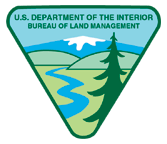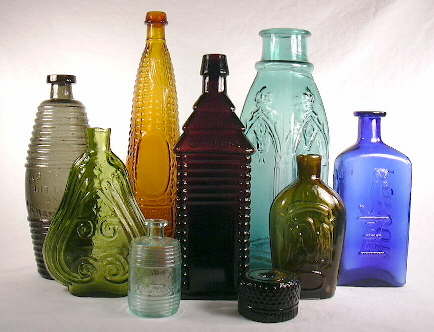
Bottle Fragment Identification
 Bottle Fragment Identification |
| Main Subject Pages |
| Home |
| Dating |
| Typing/Shapes |
|
Glassmaking ▪Makers Marks |
| Colors |
| Finishes & Closures |
| Body & Seams |
| Bases |
| Fragment ID |
| Glossary |
| References |
| Links |
| FAQ's |
| About this site |
| Website Map |
HOME: Bottle Fragment ID
 The
subject of bottle identification and dating is a difficult proposition for
complete or entire bottles. This is indicated, at
least in part, by the girth of this Historic Glass Bottle Identification &
Information Website which frequently notes the complexity of the subject
and the diversity of different bottles. Considering how complicated intact bottle
identification is, the subject of fragment identification is many times more
difficult to address since the amount of "evidence" to work with
is reduced to
just a fragment or two of an historic bottle. That doesn't mean that
fragments can not be identified, but rather, it means that fragment ID is more a matter of depth of
experience on the part of the observer in looking at and handling thousands of different bottles than a
subject that can be covered in even a minimally meaningful way by any webpage or website...or any publication for that matter.
The
subject of bottle identification and dating is a difficult proposition for
complete or entire bottles. This is indicated, at
least in part, by the girth of this Historic Glass Bottle Identification &
Information Website which frequently notes the complexity of the subject
and the diversity of different bottles. Considering how complicated intact bottle
identification is, the subject of fragment identification is many times more
difficult to address since the amount of "evidence" to work with
is reduced to
just a fragment or two of an historic bottle. That doesn't mean that
fragments can not be identified, but rather, it means that fragment ID is more a matter of depth of
experience on the part of the observer in looking at and handling thousands of different bottles than a
subject that can be covered in even a minimally meaningful way by any webpage or website...or any publication for that matter.
The following was noted on the Homepage:
Since there were hundreds of thousands of uniquely different bottles produced in the United States (and Canada) between the late 18th century and the 1950s (Fike 1987), it is beyond the scope or even possibility of this site (or any website or book) to provide specific details about more than a fraction of a percent of that variety. Even then, the bottles discussed in depth are so primarily to illustrate the presented information and concepts.
Given the above, fragment identification is an almost impossible task to describe and summarize in any fashion since any given fragment could be from any one of thousands or even tens of thousands of different possibilities. It is difficult enough for people that have been looking at and working with historic bottles for decades - like this author - to positively identify anything more than a fraction of the fragments they look at. Even then it is more often an educated guess instead of an absolute determination unless there is some distinctly diagnostic feature (e.g., diagnostic embossing, unique shape, etc.) that is unmistakable. Likewise, there exists (at least to this authors mind) no reasonable possibility of creating a "key" for identifying a small portion of a specific bottle type much less a specific bottle in what is a possible universe of hundreds or thousands or even tens of thousands of potential possibilities.
Dr. James Boow discussed some of the difficulties inherent in fragment identification in his excellent publication Early Australian Commercial Glass: Manufacturing Processes (1991). Some of that discussion follows and is directly pertinent to North American manufactured bottles:
The difficulties of identification and dating early Australian glass artefacts (sic) from observations of mould seams, or embossed names and trade marks, can be highlighted two ways.
A simple calculation of relative surface areas will show that if a bottle is broken up into 20 mm x 20 mm square pieces, the frequency with which a piece would have a mold seam, or other identifiable mark, would be low:
Traditionally made bottle*: 1 in 50 and confined to the pontil mark on the base.
Dip moulded bottle: 1 in 25 from the circular shoulder blow-over mark.
3-piece moulded bottle: 1 in 12 from the circular and two vertical shoulder seams.
2-piece moulded bottle: 1 in 6 from the circular base and vertical body and shoulder seams.These mean frequencies would be increased for artefacts of larger size and decreased if less than 400 sq. mm. in area. Although embossed names and trade marks of suppliers, distributors and glass manufacturers often provide the most valuable dating information, similar difficulties relating to frequency of occurrence exist at present. Only about forty of the seven-hundred and seventy trade names cited in the Sydney papers prior to 1850 appear at present to be associated in any way with identifiable glassware. The position for broken glass artefacts is even worse. Only a small part of each bottle, or other glassware, is usually sealed or embossed and can provide markings. Also, early consignments of common 'black' bottles were often up to several hundred times the quantity of embossed luxury products. Thus, potentially datable features may only be found once in several thousand pieces. Although this difficulty may be overcome by directing attention to clear and colourless artefacts, they only form a minor proportion even though they constitute about one-third of the names advertised at that time.
(*This was the authors term for a free-blown bottle.)
The best that can be said about fragment identification/dating is that if the fragment is large enough and clearly shows some useful diagnostic features, then what information that is possible to determine about it would follow the bottle dating and identification information found throughout this website. Obviously the bigger the fragment (or the more fragments clearly from the same bottle) the higher the likelihood of gleaning information from that fragment/fragments about the bottle they were originally part of. Comparison of significant fragments with the hundreds of images provided via the Bottle Typing/Diagnostic Shapes complex of pages is also an option the will often lead to at least partial identification success.
|
The subject of bottle fragment identification may or may not be addressed - to the extent it can - after completion of the rest of this website. It will probably be approached through an assortment of examples similar to the approach used on the Dating Examples page. Specifically, if addressed the author of this website would take users through the thought processes and information he uses to positively or tentatively identify a variety of actual bottle fragments. This will be based at least in part on the information found on this website. Working through the process with real fragments (with lots of images) should provide some feel for how this very difficult subject could be addressed. Just keep in mind that in the end, fragment identification is still largely a matter of extensive hands-on experience with many thousands of bottles of all different types from widely varying timeframes since a wide knowledge base is necessary to reasonably narrow down choices. There simply is no easy solution possible for identifying the majority of fragments. |
SEARCHING THIS WEBSITE:
To do a word/phrase
or image search of this website
one must use the following Google search link:
Search the SHA/BLM Historic Glass Bottle Identification & Information
Website
(Note: Search results for this website will be just below the
final top-of-the-page Google paid ads.)
1/1/2024
Return to the top of the this page.
This website created and managed by:
Bill Lindsey
Bureau of Land Management (retired) -
Klamath Falls, Oregon
Questions? See
FAQ #21.
Copyright © 2024 Bill Lindsey. All rights reserved. Viewers are encouraged, for personal or classroom use, to download limited copies of posted material. No material may be copied for commercial purposes. Author reserves the right to update this information as appropriate.